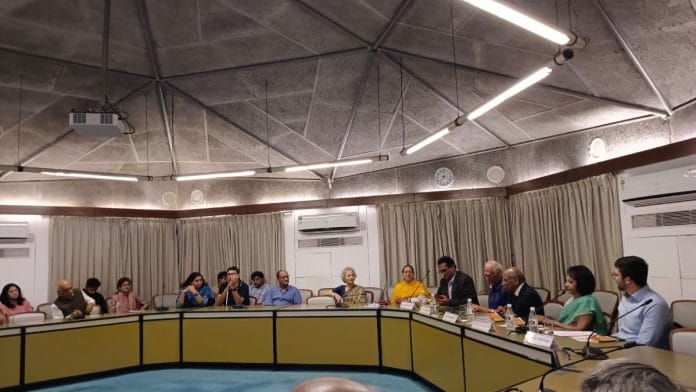New Delhi: Retired diplomat and translator Aditya Narayan Dhairyasheel Haksar, 83, is on a mission to break language barriers. He did it with his 2022 book Anthology of Humorous Sanskrit Verses, and now, he wants to make the Ramayana a global phenomenon. His chosen endeavour involves translating the Hanumannataka, a Sanskrit play by 11th-century King Bhoja’s court poet, Damodar Mishra, in English.
“My only aim is to make any book accessible to as many readers as possible through translation,” said Haksar during the launch of his new work, Hanuman Drama, at Delhi’s India International Centre recently.
A mahanataka with 14 Acts, Hanumannataka is one of the oldest plays considered true to Valmiki’s Ramayana. While it has been translated into Hindi by scholars like Ved Prakash Upadhyay, the play hasn’t breached mainstream literary or popular culture like Amar Chitra Katha comic books or AK Ramanjuan’s Three Hundred Ramayanas.
Haksar chose Mishra’s work because of its theatrical quality. Ravana is shown as the contesting bridegroom, and emotions of love, longing and loss drive the story. It’s a retelling of the epic from Hanuman’s perspective—he is the author and the actor, hence the name ‘Hanuman Drama’.
The freewheeling exchange of ideas moved from one topic to another—Sanskrit, the democratisation of information, the role of the translator, the power of a good story, and the different iterations and interpretations of the Ramayana spanning hundreds of years from India to Sri Lanka to Bali.
Having published more than 20 translated works from Sanskrit, including the first-ever English translation of the Madhavanala Katha (Madhav and Kama), Haksar is aware of the power of the translator.
“Translation is the afterlife of the text. Of how text lives on in a different form. It’s always somehow different, altered,” said translator, author and panel member Radha Chakravarty.
Through Hanuman Drama, Haksar offers readers an account of life in ancient times—social structures, family relations, hierarchy and morality.
“The text can make us conscious about some pressing questions about our own world today, especially about changing relations between the human, animal and natural worlds, modes of cultural expression, and women’s position in society,” Chakravarty told ThePrint.
Also read: First Durga Puja idol worship in Ramakrishna Mission Delhi. Kumari puja, Belur rituals
Why Haksar chose Hanuman Drama
Haksar was struck by how Ravana was portrayed in Mishra’s Hanumannataka. The many-headed king of Lanka was not as vicious as in other versions of the Ramayana—Kalidasa to Valmiki.
Haksar maintains this element in his translation of the text. Hanuman Drama’s Ravana rivals Rama’s passion for Sita. It emphasises his desire more than his ferociousness, said Chakravarty.
Mishra’s work is a dramatic retelling of Valmiki’s epic, where he portrays original characters differently. His Ravana is more of an anti-hero figure and not a villain.
“It presents the Ramayana from a very human perspective. It gives you a different flavour and opinion about the Ramayana, its story and its main characters, which is much more than just Sanskrit culture and religion,” said Shyam Saran, former foreign secretary and IIC president. Through Hanuman Drama, Haksar, he added, has brought a new dimension to secular literature and Sanskrit.
If Saran was drawn to Mishra’s secular story-telling, Debraj Mookerjee, associate professor of English at Delhi University’s Ramjas College, was struck by the “deep connection between art and religion”.
“We can feel both in this creation,” he said, referring to Mishra’s work.
Also read: A memoir about 3 Peshawar sisters traces Partition history with new lens. No blood & gore
Translators as interpreters
None of these interpretations would have been possible without the translator. They are interlocutors without whom epics and stories remain trapped within borders. Without them, English-speaking readers would never have read Homer or Dante Alighieri or Fyodor Dostoyevsky, or even the Mahabharata and Ramayana.
Chakraborty describes translation as a unique process that lends new meaning to existing texts. Every language has its own style and beauty, after all, she said.
“In translation we do not transcribe [a text] word to word or make it exactly like the previous ones. We give it a new life,” she added.
As the event came to a close, Haksar, who has brought Kalidasa, Bhasa and Vatsyayana to a generation of English-speaking readers, again stressed on “accessibility”.
“The purpose of the discussion is not to go into the depth of the story or to discuss the book but to make it accessible to as many readers and groups as possible.”
(Edited by Zoya Bhatti)






